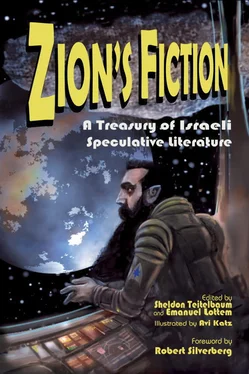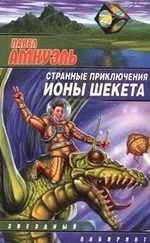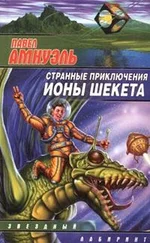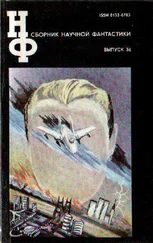Teitelbaum moved with his family to Los Angeles in 1986, where he took up new duties as West Coast bureau chief for the acclaimed film magazine Cinefantastique , as founding reporter for the Los Angeles Jewish Journal , and as a senior writer for the Jerusalem Report . Additionally, he held down a day job for three years at the University of Southern California as a science writer and, later, three more as a subcontractor to the US Department of Energy.
Teitelbaum has commented on SF/F-related themes in the Los Angeles Times , the New York Times, Forward , Time-Digital, Wired, SF Eye, Midnight Graffiti, Foundation: The Review of Science Fiction , the Encyclopedia of Science Fiction , and the Encyclopedia Judaica . He is the recipient of Canada’s first Northern Lights Award and three Brandeis University–based Jewish Press Association awards.
The Artist
Avi Katz,a veteran American-born Israeli illustrator, cartoonist, and painter, evinced interest in SF/F illustration early: while still a teenager in Philadelphia he sent a pack of his Lord of the Rings art to J. R. R. Tolkien and received an enthusiastic response from the author, who told him he was the first illustrator to portray the dwarves as he had intended.
At age twenty, while studying art at Berkeley, after being interviewed by John W. Campbell he decided to avoid the draft and Vietnam and complete his studies at the Bezalel Academy of Art in Jerusalem; he has made his home in Israel since then. He has been the staff illustrator of Jerusalem Report magazine since its first issue in 1990, and is active in the international organization Cartooning for Peace as well as the Association of Caricaturists in Israel. He has illustrated some 170 books in Israel and the United States, which have won the National Jewish Book Award, Hans Christian Andersen honors, the Ze’ev Prize, and others; he was a nominee for the lifetime achievement Astrid Lindgren Award.
A founding member of the Israeli Society for Science Fiction and Fantasy, Katz created many original book covers for SF/F published in Israel; his illustrations graced the covers of society posters and all the issues of The Tenth Dimension fanzine over the decade of its publication. He has exhibited at various SF/F conventions, including WorldCon 2003, and was guest of honor at ICon 2002. He is featured in the book Masters of Science Fiction and Fantasy Art (Rockport Press). In 2000, Katz created for the Israeli Postal Service a three-stamp series on science fiction in Israel.
The Authors
Shimon Adaf,a well-known poet, prose writer, musician, TV writer, and university educator, was born in 1972 of Moroccan parentage in the town of Sderot, near the Gaza Strip. He attended a religious school as a child and later segued to an ultra-Orthodox Sephardic junior high school, which he left after six months. Adaf completed his studies at secular schools.
Adaf began to publish poetry during his military service. Moving to Tel Aviv in 1994, he published his first short-story collection, The Icarus Monologue , which won a Ministry of Education award. This and other poetry achieved widespread translation, earning Adaf a reputation as a literary wunderkind. From 2000 to 2004 he worked at the Keter Publishing House as the youngest editor of their original Israeli prose line, discovering such genre stalwarts as Ophir Touché Gafla and Nir Bar’am. In 2004 he wrote a murder mystery, One Kilometer and Two Days before Sunset , and a young adult fantasy, The Buried Heart , the latter steeped in Jewish mythology. In 2008 he published the fantasy novel Sunburnt Faces , Adaf’s biggest hit until his most recent one, Aviva-Lo , about the unexpected death of his sister. In 2006 he launched his Rose of Judah sequence, including the Delanyesque epic Kfor ( Frost ) in 2010. Adaf followed this in 2011 with Mox Nox (Latin for Soon the Light ), an alternate-history Turn of the Screw–inspired tale, winning the prestigious Sapir Prize. This was followed by Earthly Cities , or Netherworld , in 2012.
Adaf’s literature and literary persona pose several problems to modern Hebrew literary gatekeepers. He is a polymath, and there is no gainsaying his place as one of the most erudite Israeli writers today. But his preoccupation with Talmudism, the powerful mythologies he derived from his Sephardic background, his shifting from Israel’s geographical periphery to its center and back again, from the biographical to the universalist, from the distant past to the present to the far future, as well as his sometimes hard to parse yet rich Hebrew, render his output challenging in the view of some non-genre-savvy critics.
Pesach (Pavel) Amnuelwas born in 1944 in Baku, Azerbaijan (then part of the USSR), and is known as a brainstorming astrophysicist and SF writer. Amnuel, with O. Guseynov, predicted in 1968 the existence of X-ray pulsars, which were later confirmed by the American Uhuru satellite. Amnuel and Guseynov’s catalog of X-ray sources was considered for a time the world’s most complete.
Amnuel first began publishing SF/F in Russian in 1959, his first story appearing in Technology for Youth . His first collection of stories saw publication in Moscow in 1984. Since 1990 he has lived in Israel, where he has taught at Tel Aviv University and edited several Russian-language newspapers and magazines, including Time, Aleph , and Vremya . Since emigrating to Israel, he has published the novels Men of the Code (1997), Three-Universe (2000)—the latter involving social satire and kabbalistic mystery, with events transpiring in a mid-twenty-first-century Moscow run by the Russian Mafia and Israeli rabbis—and Revenge in Dominoes (2007), as well as sundry SF/F collections, short stories, and detective novels.
His work appears regularly in Russia, where he continues to claim a large fan base. He has won multiple awards, including The Great Ring, for achieving the greatest popularity among contemporary Russian writers, the 2009 Bronze Icarus Award of Russian Science Fiction, and the Aelita (the Russian equivalent of the Hugo) in 2012. “White Curtain” is one of several stories and novellas in his Multiverse cycle. These include the yet-to-be translated novellas “Branches,” “Facets,” “What Is Behind This Door?” and “Seeing Eye.” Appearing in The Magazine of Fantasy & Science Fiction in 2014, “White Curtain” figured in Gardner Dozois’s 32nd Best SF of the Year anthology in 2015. It was Amnuel’s first publication in English translation.
Rotem Baruchingrew up in Tel Aviv, Ramat Gan, Petach Tikva, and Giv’at Shmuel, all in Israel, as well as in Swiss suburbia. She began reading science fiction and fantasy at the tender age of eight and started writing it at about the same age. For years she has combined fanzine writing with original fiction, published in both printed and online magazines, and then went on to study screenwriting at Tel Aviv University’s School of Film and TV.
For the past ten years she has been writing plays for Israeli LGTB groups, such as the Gay Ensemble, produced on commercial stages. She was a dialogue writer and consultant for a children’s show, The Dreamers , broadcast by an Israeli TV channel, and has directed several plays and musicals for a number of theaters, festivals, and conventions, including an interactive production involving audience choices. Her Internet series, The Grey Matter , filmed in the United States, can be seen online. For the Israeli youth magazine Rosh 1 she wrote two story series, published over a couple of years.
Читать дальше






